 |
| Self portrait in cubes |
The weather was touch and go in Brisbane, so we spent a bit of time exploring the museums. My first stop was the GOMA, or Gallery of Modern Arts, which is conveniently located in the Southbank area next to the State Library, a Science Museum and the Queensland Art Gallery.
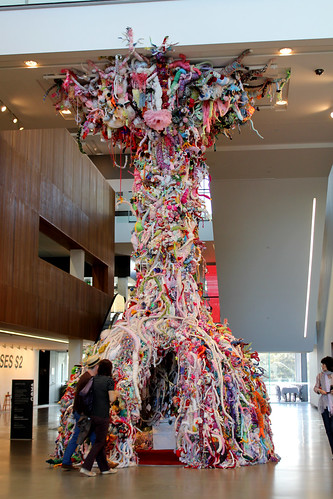 |
| Hiromi Tango / Pistil |
|
 |
| Detail of Pistil |
|
The first thing we saw when we came in the door was what looked like a kid's dream teepee. If I had this little hideaway in my bedroom as a child, I would have camped in it every night. From far away, it looked like it was built from the carcasses of a thousand stuffed animals, but up close it was more abstract.
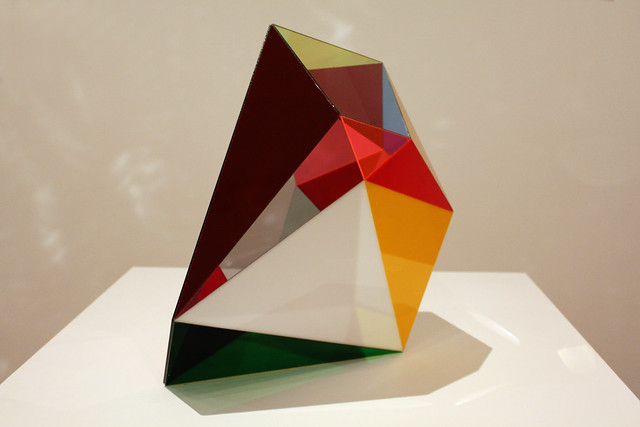 |
| Gemma Smith / Australia 1978 / Boulder Prototype #2 2008 / Laser-cut Perspex, ed. of 22 unique works |
Obviously, I loved this plexiglass crystal from artist Gemma Smith. I remember dreaming up something like this in college, but never actually getting around to building it. At least someone has.
These frames would look great as a gallery wall in someone's house, don't you think?
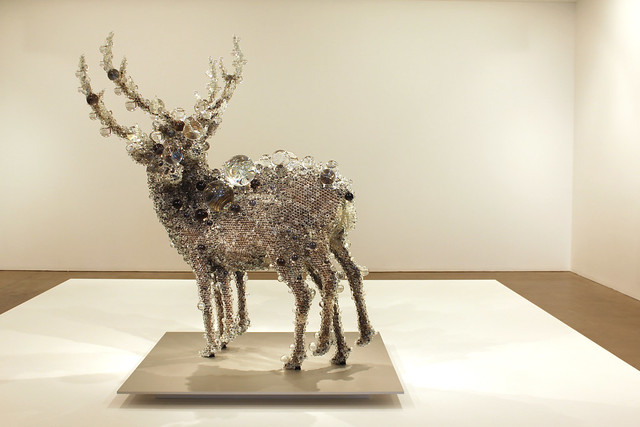 |
| Kohei Nawa / Japan b.1975 / PixCell-Double Deer #4 |
Kohei Nawa
Kohei Nawa's sculpture PixCell Double Deer #4 transforms the body [sic] of two taxidermied deer, purchased through an internet auction site, by covering them with transparent glass and resin beads. In the process, Nawa dramatically changes our perception of the original creature; the surface of the animal is fractured, magnified, and distorted through the images captured inside the spheres. Viewed through this shell, the elk's [sic] textures and colours are filtered through, and dissipated into, myriad individual surfaces, like the pixels on a computer screen. In using these media, Nawa aims to destabilise our sense of what is real and what is virtual. He is fascinated with how we gather information from our environment via the sense of sight and touch. To the sense of sight, everything around us is a series of light-reflecting surfaces, and everything we can perceive by touch is covered by some kind of skin. Nawa focuses on the outer layer, or epidermis, of things to draw attention to how we identify with the world at the level of these skins or membranes. In doing so, he creates sculptures that reflect on our information society.*
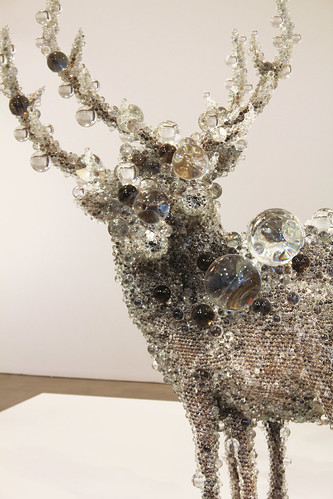 |
| Kohei Nawa / Japan b.1975 / PixCell-Double Deer #4 |
|
 |
| Bindi Cole |
|
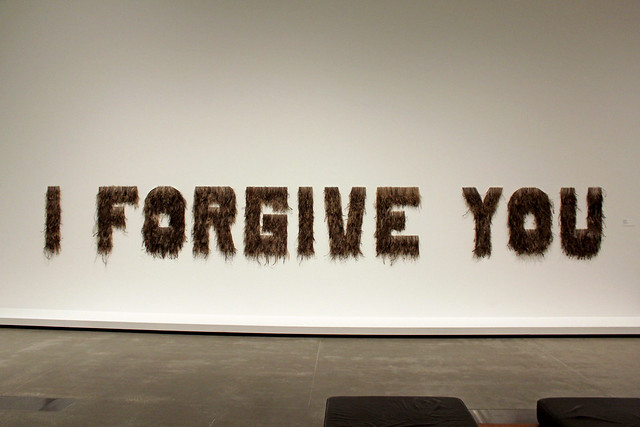 |
| Bindi Cole |
Bindi Cole
This work is the result of a deeply personal exploration of many issues in the artist's life. Bindi Cole's grandmother was a member of the Stolen Generations, and this work can be read as a reply to the Apology to Australia's Indigenous Peoples made in 2008 by the prime minister, which specifically referred to the Stolen Generations. The statement "I forgive you" is also a way for Cole to reconcile incidents from her past - abuse, neglect and racial ignorance - allowing her to move into the future free from problems that had been weighing her down. As she noted:
I had to go through a process of healing and a huge part of healing was around forgiveness... As I forgave I was able to take my power back.
Cole offers this as a possible answer to the problems faced by Aboriginal communities similarly afflicted by violent and abusive histories. She says, 'I think the path is through forgiveness and allowing ourselves to be healed.'
Emu feathers are used here like a cloak, protecting the vulnerability and raw emotion of the statement, while also softening the almost confrontational nature of the large-scale text.*
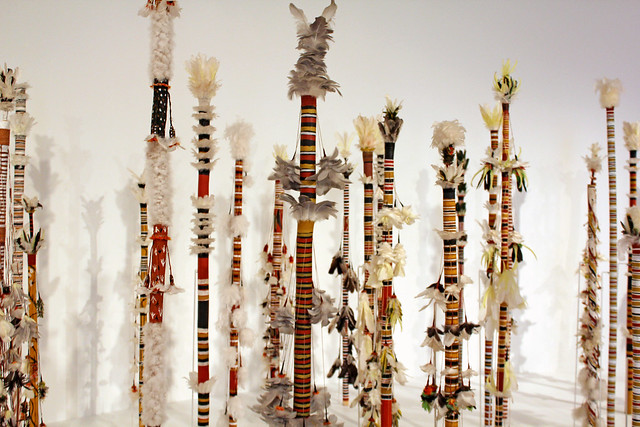 |
| Aboriginal Morning Star Poles |
There were lots of beautiful Aboriginal creations in the gallery, from the sculptures above to the paintings below.
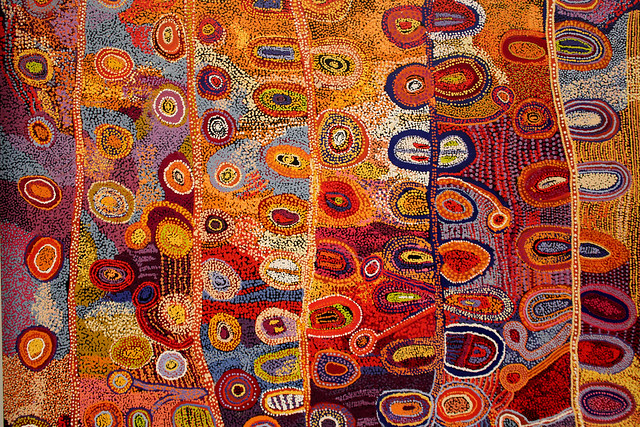 |
| Detail of Amata community painting |
Amata Painters
Amata community is located in the Anangu Pitjantjatjara Yankunytjatjara (APY) lands of north-western South Australia. In the 1970s, Amata women were encouraged to learn batik, natural dyeing, spinning, weaving and leatherwork. Minymaku Arts (meaning 'belonging to women') was set up in 1997 to provide a permanent home for the arts for women in the community; however, in 2005, the centre was renamed Tjala Arts, with both men and women painting abstract imagery adapted from traditional symbols and concepts.
Tjala Arts is now the hub of activity in the Amata community and a leader in the vibrant Western Desert painting movement currently reinvigoration Australian contemporary art. It is important to Tjala Arts to foster intergenerational cultural learning, so programs have been introduced to bring young people into the centre. For these paintings, grandmothers, their daughters and grandchildren along with other family members have collaborated to produce what they regard as their most significant body of work to date.
In caring for these precious works, the Gallery has forged an enduring relationship with the Amata community - they know where their paintings are held and appreciate that they will be viewed and enjoyed by the public, while remaining accessible to their Anangu families for generations to come.*
 |
| Detail of Amata community painting |
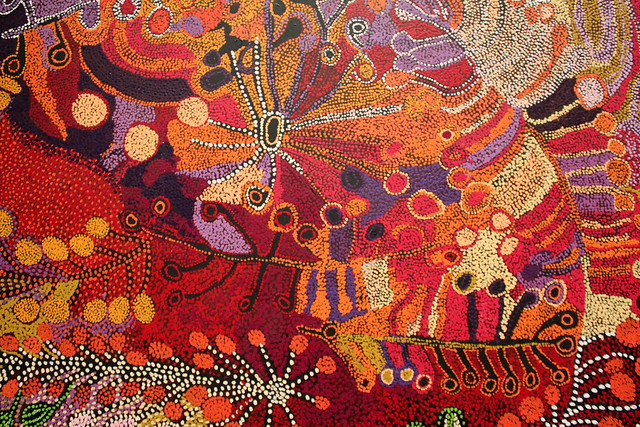 |
| Detail of Amata community painting |
There was a special exhibition on featuring Australian women artists. I really loved the painting style of Jennifer Mills and the impact of Deborah Kelly's piece
The Miracles.
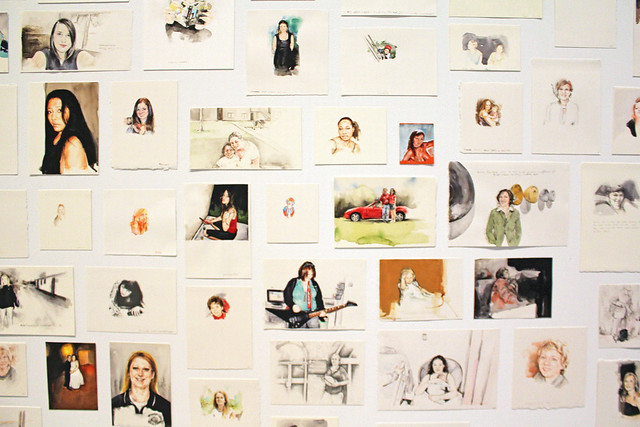 |
| Jennifer Mills |
Jennifer Mills
There are many Jennifers in the world - even many Jennifer Mills. Here, the Australian artist Jennifer Mills gathers 325 other women named Jennifer Mills from across the globe found through the internet. These Jennifer Mills have been transformed from their original internet images through this Jennifer Mill's tender watercolour paintings, which are equally attractive and non-judgemental.
The phenomenon of trawling the internet to contact strangers has led many people to unexpected consequences, such as finding one's googleganger, an internet double. You can read an essay by one of the artist's googlegangers, the Australian writer Jennifer, in the exhibition publication. She notes the strange but dislocated intimacy of the internet: 'The idea that in the mass of difference and differentiation you might have something in common with a stranger has a kind of dizziness about it.'
All the images of these various Jennifer Mills were posted online by themselves, or perhaps family or friends. Though they were once widely dispersed, they are now brought together in this one assembly. As writer Jennifer Mills notes: 'These Jennifers have traveed through the hyperreality of the network and come back home.'*
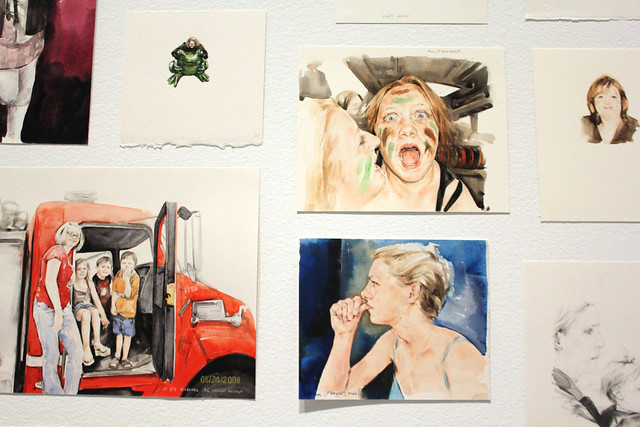 |
| Detail of Jennifer Mills |
 |
| Deborah Kelly, The Miracles |
The Miracles provokes thinking about what constitutes a family today. The work documents real families in which children have been conceived with Assisted Reproductive Technologies (ART), ranging from advanced IVF treatments to DIY home ingenuity. The obstacles to traditional conception are not disclosed, although we can sometimes infer what they might be through observing the range of kinship structures- traditional hetero-nuclear, single-parent, extended, expectant and same-sex families. In each situation, however, it is clear that the children are treasured. They are miracles- conceived "immaculately" - delivering an incomparable sense of meaning, purpose and a profound blessing to their parents.
Kelly's photographs are presented in the circular tondo format and are fashioned after specific Renaissance religious paintings with disputed attribution, authenticity or provenance. Similarly, families that have relied on ART have often been subjected to questions about their origins - both the babies and the families. The families, here, answer any questions about their legitimacy quite simply through their affirmative presences.*
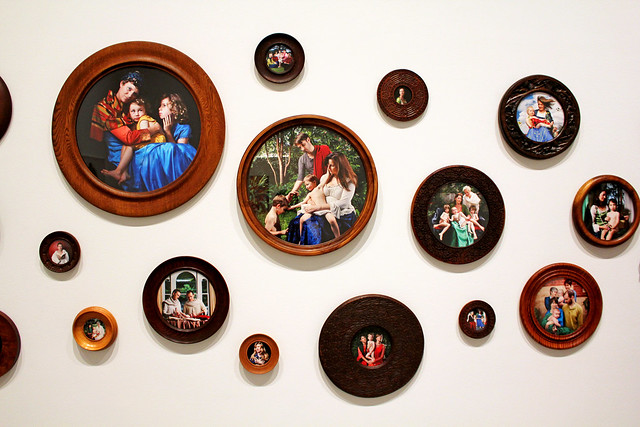 |
| Detail of Deborah Kelly, The Miracles |
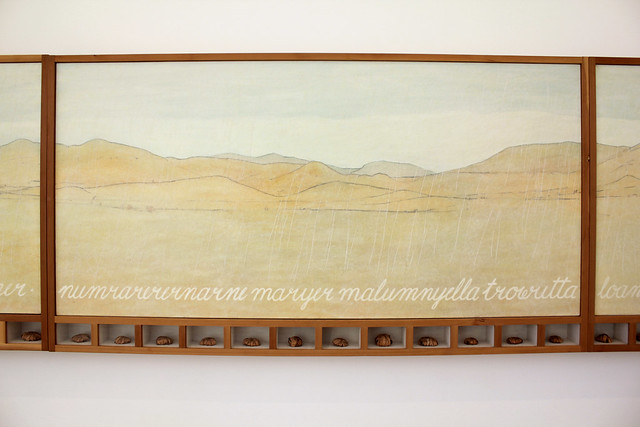 |
Bea Maddock / Australia TAS/VIC b. 1934 / Tromemanner - forgive us our trespass I-IV 1988-89
Pigment wash and encaustic with wrapped and tied artifacts on canvas |
Tromemanner - forgive us our trespass I-IV explores an Indigenous connection to the land, evoking the current of time and the erasure of the human subject. This panoramic landscape is based on the Saltpan Plains in northern Tasmania, near Maddock's studio. The word 'Tromemanner' translates as 'my own country' in the language of the Oyster Bay clan from Tasmania. Because much Aboriginal culture was traditionally passed down through the spoken word, the presence of text across the landscape acts as a kind of memorial. By becoming script, the words are no longer 'alive', but 'dead', and can speak only of loss. This is emphasised by the 48 wrapped burial emblems - the number 48 represents the approxmate number of Tasmanian sub-tribal groups.
The soft, melted wax and pigment surface of the painting is scratched with lines. These resemble rain or cuts made on the bodies of the deceased in some Aboriginal mourning rituals. The painting speaks of the dispossession experienced by Aboriginal peoples, while simultaneously conveying the deep spiritual attachment to the land.*
* All quoted material above is from the museum placards and presumably belongs to the museum or to the artists. My intention in sharing it is to help explain the work pictured, not to claim it as my own.
 |
| Brisbane panorama, showing the CBD on the left and Southbank on the right. |
Art museums never fail to excite my brain and inspire me. After I left for the science museum, I continued to overload my senses with beautiful things from the natural world.
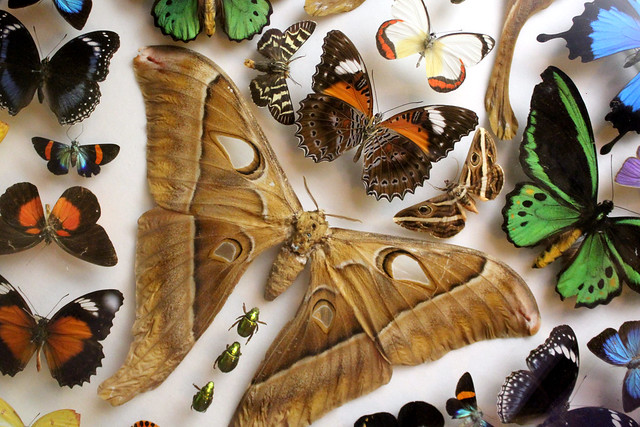

Eventually, after leaving both museums, I was seeing beauty in everything...
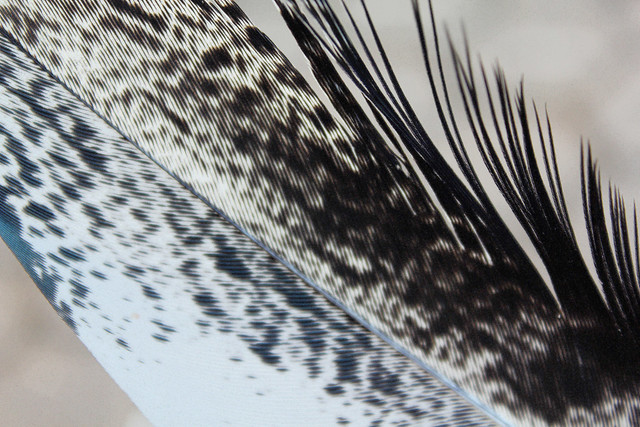 |
| Australian White Ibis feather, found on the ground at the Brisbane Botanic Gardens |
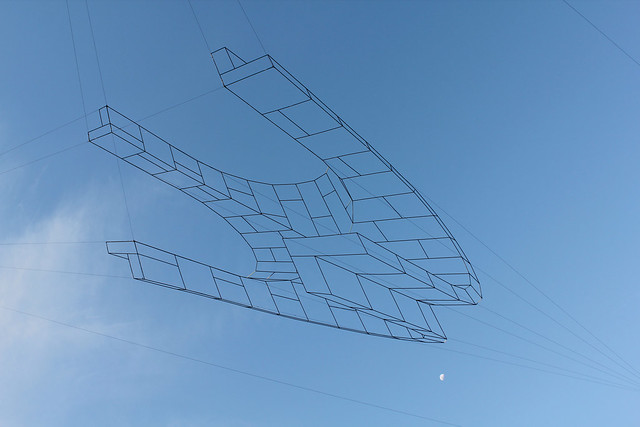 |
| Neil Dawson's Canopy, with the moon in the background |
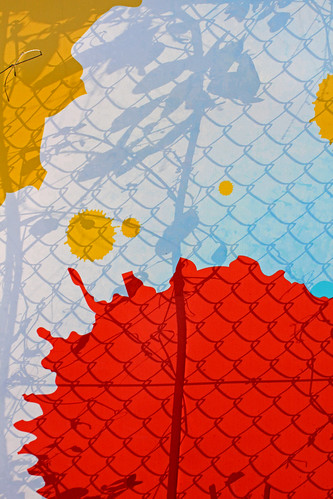 |
| Detail of banner with shadows behind showing through |
|
 |
| Tiny red bell flowers in Southbank |
|
What's inspiring you lately?



































No comments:
Post a Comment